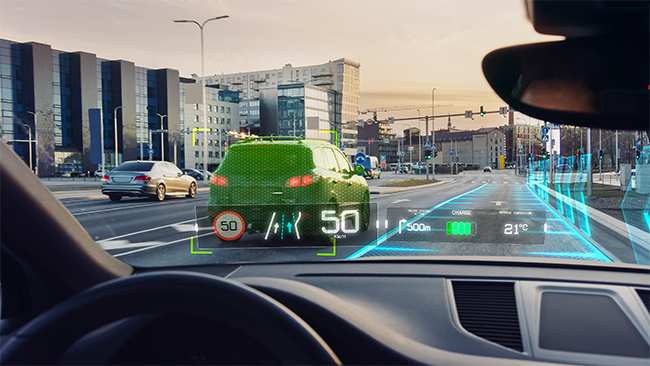An AR-HUD (Augmented Reality Head-Up Display) uses augmented reality (AR) technology to overlay detailed and informations such as navigation arrows, road signs, and warnings onto the actual scenery on the windshield. This enables drivers to understand road information more intuitively.

Documents related to Display Controller IC/Interface IC for Automotive
You can request the following documents related to Display Controller/Interface IC for Automotive. Please feel free to request.
What is HUD in cars?
An automotive HUD (Head-Up Display) is a system that projects essential driving information—such as speed and route—onto the windshield or other surfaces in front of the driver.
HUD was originally a display system used in military aircraft, but today it is widely adopted in many automobiles.
Its greatest advantage is that drivers can check information while maintaining their forward view without having to lower their gaze to look at meters or navigation screens, thereby reducing distractions and lowering the risk of accidents.
As vehicles become more advanced, there is an increasing need to convey various types of information to drivers. However, the amount of information a driver can process while driving is limited, so the challenge lies in how intuitively this information can be communicated.
Difference between AR-HUD and HUD
HUD:
A system that displays information such as speed and navigation within the driver's field of view while driving.It projects onto the windshield, allowing the driver to check information without taking their eyes off the road.
Typically, images from a small display installed inside the dashboard are enlarged and reflected onto the windshield. It displays basic driving-related information such as speed and direction indicators, similar to what is shown on meters and the CID (Center Information Display).
AR-HUD:
Like HUD, AR-HUD displays information on the windshield. The difference is that it uses augmented reality (AR) technology to overlay more detailed and intuitive information such as navigation arrows, road signs, and warnings onto the actual scenery.This allows drivers to grasp road information more intuitively.
Main Features of AR-HUD
Display of Navigation Information:
Projects directions and turn-by-turn instructions onto the windshield, allowing the driver to check information without taking their eyes off the road.
Display of Speed and Vehicle Information:
Shows important vehicle information such as current speed and fuel level in real-time.
ADAS Warnings:
Works with Advanced Driver Assistance Systems (ADAS) to display collision warnings, lane departure warnings, etc.
Recognition and Display of Traffic Signs:
Recognizes road signs and displays information such as speed limits and stop signs.
Augmented Reality (AR) Display:
Overlays information onto the actual road environment to enhance the driver's situational awareness.
Role and Benefits of AR-HUD from the Driver's Perspective
Improved Safety:
Enhances safety by providing intuitive driving information.
Improved Vehicle Operability:
Allows for more intuitive driving.
Convenience:
Enables checking more detailed and intuitive information without moving the eyes.
Epson's HUD IC
Epson’s HUD IC, the “S2D13V42” is a high-resolution head-up display controller that corrects image distortion to match the curved surface of a vehicle’s windshield. It processes image data streamed from the host SoC and outputs it to the HUD’s compact display.
This product does not require external memory, enabling the rapid development of head-up display systems using proven Host (SoC).
Additionally, it supports pitch correction and display safety functions required for AR-HUD, supporting the construction of more reliable display systems.
Furthermore, this product meets the stringent quality requirements for automotive use, with an operating temperature of up to 105°C and compliance with the AEC-Q100 standard.

Documents related to Display Controller IC/Interface IC for Automotive
You can request the following documents related to Display Controller/Interface IC for Automotive. Please feel free to request.
